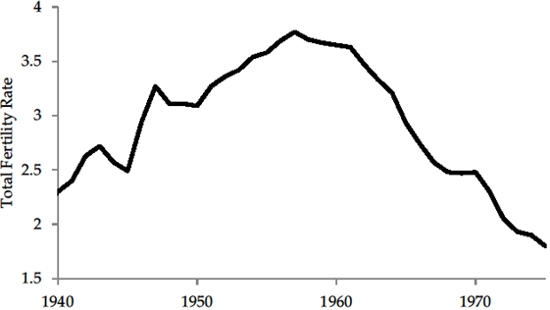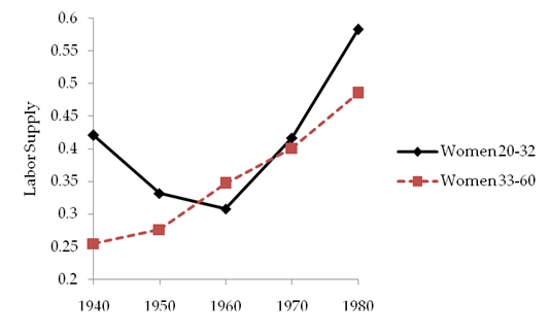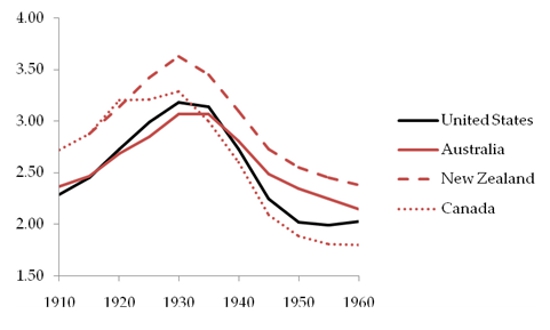Baby Boomers Where Did Many of These New Families Live During the 1950s?
 The two decades following World War II were characterized by a massive upswing in nascency rates in the US and other countries – the so-called 'baby Boom'. While the traditional caption of the Babe Smash is that families made up for babies that were delayed due to the state of war, in new enquiry Matthias Doepke suggests an culling caption. He argues that the Baby Nail of the 1950s was fuelled past the crowding out of younger women from the labor force past older women who had gained work experience during the war. These younger women so got married and had babies earlier, and in greater numbers.
The two decades following World War II were characterized by a massive upswing in nascency rates in the US and other countries – the so-called 'baby Boom'. While the traditional caption of the Babe Smash is that families made up for babies that were delayed due to the state of war, in new enquiry Matthias Doepke suggests an culling caption. He argues that the Baby Nail of the 1950s was fuelled past the crowding out of younger women from the labor force past older women who had gained work experience during the war. These younger women so got married and had babies earlier, and in greater numbers.
Between the end of World State of war II and the early 1960s, the Usa experienced a remarkable baby boom. The total fertility rate (a measure of the number of children each adult female will take, given electric current fertility patterns) increased from just over ii earlier the state of war to a peak of shut to 4 children per woman in the late 1950s (Effigy one). The large variations in cohort sizes generated by the baby nail have shaped the U.s. economy ever since, including the economic boom in the 1990s when the baby boomers were in their height earning years, and the daunting challenges in financing retirement and wellness benefits in the coming decades equally the baby boomers enter retirement.
Effigy 1 – Total fertility rate in the United States

While there is substantial agreement on the consequences of the infant boom for the US economy, the underlying causes of the ascent in fertility have remained controversial. A defining signal in this debate is the part of Globe War II in explaining post-war fertility. Initially, the fact that fertility rates started to rise soon afterwards soldiers returned home from the battlefields suggested to many that the baby boom may exist due to families making upwardly for the babies they did not have while husbands were serving in the military. Withal, a detailed look at the data reveals that this machinery can explain at most a small-scale fraction of the baby blast. Fertility peaked in the late 1950s, and most of the rise in fertility is due to young mothers under the historic period of 25. Hence, the mothers who gave birth at the peak of the baby nail were mostly too young to exist married to men who served in the war. Given this mismatch, for many years enquiry into the causes of the baby boom has focused on mechanisms unrelated to the war, such as innovations in household technology or the consequences of the Great Depression.
In recent enquiry with Moshe Hazan and Yishay Maoz, nosotros debate that the World War II was responsible for the babe boom afterwards all, albeit through a more subtle machinery than the desire for kids of returning soldiers. In our view, much of the baby boom can exist explained by the ramifications of World War II for women'southward labor market opportunities. Indeed, the state of war was a watershed moment for American women's office in the labor force. As the men were fighting in Europe and Asia, millions of women joined the labor forcefulness, and they were responsible for a large part of the ascent in wartime production. Women had been working earlier the state of war, as well, simply nigh exclusively in their early twenties before getting married. The big modify during the war was that older married women, including those with children, likewise entered employment.
The surge of female employment during the war proved to exist a watershed, considering many women who joined the war product endeavour liked the feel, and decided to stay in the labor forcefulness even afterwards the men returned home. Hence, in the two decades after the terminate of the state of war we discover a large increase in the labor supply of married women.
Now as far as explaining the baby blast is concerned, pointing out that the war increased female employment may appear to brand the puzzle even bigger – after all, having children and having a job are two activities that compete for fourth dimension, so that a rise in female employment by and large tends to go along with fewer babies. However, the key to our argument is that the surge in female employment had opposite furnishings on two different cohorts of women: the war generation of women sometime plenty to work in World War II, and younger women still in schoolhouse during the state of war who would attain childbearing in the late 1940s and 1950s.
The women of the war generation benefitted from the additional piece of work experience, and thus continued to work at high rates throughout their adulthood. In contrast, women in the younger cohort had a much harder time finding employment, because they had to face potent competition from the experienced war generation. Before the war, female employment was the about sectional domain of young, single women. As these women married they used to free upwardly jobs for the next generation. In the post-state of war years, in contrast, many jobs were already taken past the older women, resulting in dire employment prospects for the post-obit cohorts.
With the older women dominating the labor market, young women were crowded out, and had to look for something else to do. Many of the younger women adjusted by getting married and starting to have babies a little earlier than they would take had they been employed. Ultimately, they concluded upward building bigger families with more children. It is the story of these younger women that explains most of the baby boom.
Figure 2 – Total labor supply past younger (xx-32) and older (33-60) women in the United States (as a pct of labor supply by men in the same historic period group)

Our account of the baby smash is consequent with the ascertainment that the employment of younger (i.east., childbearing age) and older women moved in opposite directions after the war (Figure 2). Bear witness on variation in the infant boom across United states states is likewise consistent with the mechanism. States with higher mobilization rates (i.e., a higher fraction of men joining the armed forces) had a larger surge in female person employment during the war and a larger rise in fertility later the war. A final piece of evidence comes from variation across countries. Many countries were affected by the war, merely only a few countries experienced a large rise in wartime female employment. Nosotros should expect the mail-state of war baby boom to be large only those countries where female employment surged. The evidence lines up precisely with this prediction. Canada, New Zealand, and Australia are the three countries with a war fourth dimension experience very similar to the United States, in terms of a large ascension in female person employment and besides in terms of the absence of major war time destruction (which may accept a split effect on post-war fertility). Figure 3 shows that the baby smash was large and similarly timed in all of these countries. In contrast, in the neutral European countries (which also escaped war time destruction, but didn't experience a rise in female employment), there is no pronounced rise in fertility later the war (Effigy four).
Figure 3 – Completed fertility rates (i.e., average number of children per woman in a given nascence accomplice) in the United States and allies with a similar state of war experience.

Annotation: The baby smash corresponds to nascence cohorts (i.e., nascency yr of the female parent) 1920-1940.
Figure 4 – Completed fertility rates (i.e., average number of children per woman in a given nativity cohort) in the The states and neutral countries.

Note: The baby smash corresponds to birth cohorts (i.e., birth twelvemonth of the mother) 1920-1940.
Today's demographic challenges are quite different from those of the babe boom catamenia; notably, many industrialized countries now endure from extremely low fertility rates, population aging, and population turn down. Nevertheless, our work suggests that the cardinal tradeoff that drives fertility today, namely betwixt piece of work and careers on the one manus and childbearing on the other hand, was equally responsible for explaining fertility trends during the postwar baby nail.
This article is based on the newspaper "The Baby Boom and World War II: A Macroeconomic Analysis" in the Review of Economical Studies.
Featured epitome credit: USMC Athenaeum (Flickr, CC-BY-2.0)
Delight read our comments policy earlier commenting.
Notation: This article gives the views of the writer, and not the position of USAPP – American Politics and Policy, nor the London School of Economic science.
Shortened URL for this post: http://fleck.ly/1WziuSg
_________________________________
Well-nigh the writer
 Matthias Doepke – Northwestern Academy
Matthias Doepke – Northwestern Academy
Matthias Doepke is a Professor of Economics at Northwestern University, an NBER Research Associate, and a CEPR Research Boyfriend. He received a Ph.D. in Economics from the University of Chicago in 2000. His enquiry areas include economic growth and development, political economic system, macroeconomics, and monetary economic science.
Source: https://blogs.lse.ac.uk/usappblog/2015/11/04/how-rosie-the-riveter-led-to-the-1950s-baby-boom/
0 Response to "Baby Boomers Where Did Many of These New Families Live During the 1950s?"
Publicar un comentario